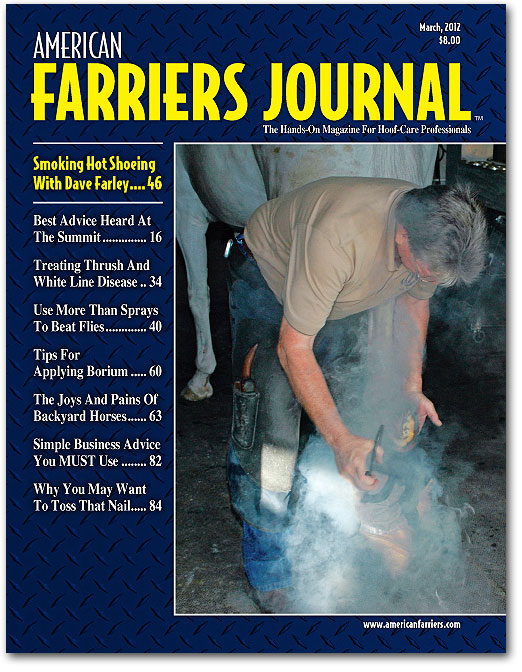Bob Smith of
Pacific Coast Horseshoeing School was kind enough to
review
Millwater's Farriery: The Illustrated Dictionary of
Horseshoeing and Hoofcare for the recent issue of the
American Farriers Journal.
The blurb from the review is
"An excellent reference for shoers,
owners and farrier students..."
He also observed that the dictionary had evolved into a
"mini-textbook" of farriery. Something I realized myself as I was
putting it together.
This actually gave me pause at the time... After all, we are
blessed with some really great, full-on farrier textbooks in this
day and age. It was certainly beyond the intended scope of the
lexicon project to 'compete' with them.
But the massive textbooks from
Butler and
Gregory are designed
for dedicated students going through training at the better farrier
schools on the way to careers as professional farriers, and retail
for
several times the list price of my book... I know a lot of
people interested in farriery aren't starting-out at that level.
Especially in times like these, I figured there was a place for an
entry-level primer rooted in the fundamentals. Something to get the
prospective hoofcare provider (or horseowner who has to resort to doing their own) started so they can find out if it's
really for them, then they can move-on to the more advanced training
and texts appropriate to their chosen career paths.
Smith did bust my chops on the "selected resources" appendix of
the book... And not without justification.
I included
Crudoir on the "periodicals" page. At the time the
review was written, all there was of the magazine was a webpage
announcing the upcoming launch... Since then, that has been
replaced with an announcement that they've given-up on the plan for
a new magazine as-such, and are going "another direction".
Well, that's the peril of reference book publication. Even in
this modern age of fast publishing tech (and believe me, it's like
greased lightning compared to the 'good old days'), I still had to
put the content to bed and shift to formatting and set-up long
before the actual release. I'd been in-touch with the intended
publisher of
Crudoir, and she was in-earnest about making the
magazine a reality... I didn't have the option of waiting to
see if it caught-on, so I included it. Actually, I figured that
even if it didn't fly, it'd be an interesting footnote in the
future.
Henry Heymering's bibliographic history tome
On The Horse's
Foot cites a number of publications that are only known due to their
being mentioned in old reference books.
Then there was the fact that, with the folding of so many other
farrier periodicals, the
American Farrier's Journal is effectively
the Last Man Standing. Frankly, I had to stretch a little bit just
to keep AFJ from being completely alone on the page!
As to the weakness of the "Internet resources" page, he's got a
point there. In truth, that section is almost vestigial. Left-over
from earlier dictionaries before Google was built right into all our
browsers, when you actually needed to know a URL to get to a
resource.
I certainly didn't intend to snub the AFJ website in this
section. Since a URL was included on the "periodicals" section,
where AFJ was at the top of a far less crowded page, I figured
putting it in the "Internet" section was kind of redundant.
With the ever shifting sands of the Internet, I'm also a little
reluctant to reference new Internet documents, as they have a nasty
tendency to get moved or gone as websites get 'updated' and
redesigned. My personal favorites/bookmarks lists attest to this
with tons of now
'404' links.
On a side-note, I included contact information with the Press
Release which was really intended in-case the folks at AFJ needed to
touch base with me. (Sort of traditional PR format.) Unfortunately,
I apparently didn't make that clear, as my farm land line and snail
mail address got published with the review... I rarely use the
land-line, and can barely hear incoming messages due to interference
from the electric fences... And all orders are ultimately processed
over the Internet anyway. (I do not have a warehouse of books and
mail packaging like the not-so-good old days.)
If someone really hates to order over the Internet, they can ask
at a brick and mortar book store. They're not likely to have
Millwater's Farriery in stock (as it's a specialty kind of book),
but it is available through regular distribution channels, so they
can order it.
- 30 -
.


